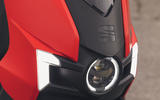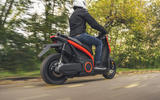What is it?
The new Seat MO is an all-new electric scooter for urban use, very similar in size, carrying capacity and performance to the ubiquitous breed of 125cc four-stroke models, usually Japanese, that have been plying Europe’s city centres for decades.
There’s one big difference: because it’s battery-powered, it has no toxic exhaust emissions and contributes nothing to atmospheric CO2. On sale in the UK from this month onwards, MO gives the Volkswagen Group’s emergent Spanish brand a golden opportunity to enhance its green credentials, to begin fulfilling a promise to offer transportation solutions and not just cars, and to strengthen its already impressive youth image.
Though the name and badging say Seat, MO is a ‘white label’ product, fully built by the Italian company Silence, which makes a very similar-looking own-brand product that’s already sold here by a Midlands-based importer, Silence UK, launched last year by a group of ex-Jaguar Land Rover executives.

What does it cost?
There’s just one MO price – £4996 – which is the amount you pay after deducting the £1500 incentive the UK government currently offers buyers of electric motorcycles. Seat’s purchase price is just £1 more than the UK cost of Silence’s own-brand equivalent, the S:02, and translates to a ‘drip feed’ cost of £95 per month for three years; PCP deals are not offered. By comparison, Honda’s best-selling PCX125 petrol scooter, broadly similar in performance, lighter to handle and arguably better made, costs £3299 – a very solid saving.
True, the Honda is likely to need slightly more expensive annual servicing than the MO, but the warranty on the latter’s 7kWh lithium ion battery is only four years, and (though experience so far suggests such batteries last considerably longer) no one can yet quote a definitive battery life.

















Join the debate
Add your comment
Quite impressive actually, especially if you get your power from a green supplier, not only that it removes polution from the most important place, cities. Sure there be some luddites with the usual it's useless as it can't do 500 miles without charging and then takes more than 10 minutes.
Isn’t Silence a Spanish brand, founded by Carlos Sotello? They manufacture e scooters in Barcelona, not too far away from Seat. I thought Silence UK was just a retail operation. The Supersocco Chinese alternatives not only look more exciting, but are less expensive too.
I dont normally read the bike stuff Autocar has taken to filling its web pages with, and i dont know what drew me to read this. The one take away point i can see is that ignoring the tax payer funded incentive this this thing is double the price of an ICE Honda nea enough.
Will it actually last long enough to revover the extra CO2 from its manufacture? I also take issue with the suggestion that its use contributes nothing to CO2. Right now the grid is over 50% fossil fuel powered, and if there is more demand (like plugging in your electric bike) the extra will come from 100% fossil fuel.
So its expensive, costs the tax payer a lot of money, and is unlikely to be low CO2 over its life. Definitely the way forward!
In future i will remember not to read any more electric bike rubbish on Autocar
emm all the consumer cares about is the sticker price so the double the price of the honda is pointless. Yes you'll get the CO2 back, just like BEV cars. 50% of grid power is fossil, well that's 50% more than an ICE moped. Indicates pretty good progress actually, from 5% to 50% in 20 years. Oh and no fumes for city walkers.
Pretty good article although next time please do a bit more riding, KTM-E off road pretty please